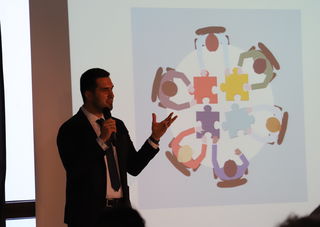Society for the Psychology of Aesthetics Creativity and the Arts History

Vlad Glaveanu opening the Creativity Week by talking most the Creativity Manifesto
Source: Webster University Geneva
The European Collaborative Creativity Conference brought together a group of international scholars to put together a puzzle of creativity, edifice from neuroscience to cultural influences. During the week at the Webster Center for Creativity and Innovation in Geneva and the Marconi Plant for Creativity in Bologna, the scholars challenged the common tendency to equate creativity with thinking of new ideas. Creativity is much broader than coming up with ideas. As described past a large group of scholars in the Creativity Manifesto and discussed at the conference, nearly importantly, creativity is action.
What does it mean that inventiveness is action? It means that creativity goes beyond thinking, as unremarkably thought by laypeople and implicit in the choices of inventiveness researchers. Creative thinking tasks are the most common measures in experimental studies (studying many questions, from the role of mood to the effects of multicultural experiences on creativity) and practical inquiry (such equally testing the success of creativity training programs). Even so, creators don't end there. Ludwig van Beethoven didn't but come up with tunes; he also wrote nine symphonies. Agatha Christie didn't just have an idea for stories nigh an eccentric Belgian detective; she painstakingly worked on each of 33 Poirot novels.
Scientists tend to recollect that at that place isn't annihilation more practical than a adept theory. So let me take you lot on a bout of the theoretical definition of what creativity is and how we should study it through the example of the role of emotions and emotional intelligence in creativity.

Source: William Iven/Unsplash
Creativity Affects How People Relate to Themselves, Others, and the Globe
Creativity changes the individual and contributes to their well-existence. For instance, creativity in how people deal with challenging emotional situations can make them more successful in addressing these challenges.one An adolescent who responds to a school dance being canceled past organizing a protest or organizing a dance in a park is more likely to manage their frustration and disappointment successfully than someone who responds past letting off steam by punching a pocketbook. Similarly, everyday artistic activities predict personal growth,2 a component of psychological well-existence.
Creative action as well changes the globe. We can easily recall of examples of how the world was inverse by great works of art (such as the introduction of perspective in Renaissance art!) or scientific discipline (penicillin!). Perhaps less apparently, creativity also changes the globe through social movements that modify society itself. This creativity tin pull in previously excluded people, like social movements aiming to create greater equity in instruction and the workplace).
We Cannot Talk Nigh Creativity as a General Unified "Thing"
Creativity is not unitary. Rather, we tin can learn about specific aspects of inventiveness. As researchers developed a model describing the function of emotions in inventiveness,3 we depict what can be learned from different aspects of creativity.
What creative work people cull is predicted by their emotional traits, including their interests and passions. Quick generation of creative ideas is related to people'southward electric current mood. Positive and energized moods are benign for performance in quick brainstorming sessions (that take three to iv minutes), but these moods terminate to be relevant for creative thinking that takes more than a few minutes. Ability to successfully manage emotions becomes an important predictor of student creativity, as rated by their peers.
All of those aspects—the conclusion of what kind of piece of work to pursue, generating ideas, being recognized equally creative by others—contribute to understanding creativity, but depend on dissimilar traits and abilities.
We Need to Learn From Both Qualitative and Quantitative Studies
A recent study at the Yale Center for Emotional Intelligence shows different lessons from quantitative vs. qualitative methods. We surveyed artists—painters, sculptors, photographers, creative writers, musicians, and choreographers—and asked them well-nigh their emotions in the creative process. As in many previous studies, artists rated positive emotions of interest, curiosity, love, and happiness as the most common in their piece of work.
Nevertheless, when we asked them to depict emotions relevant to their piece of work in their ain words, a more than complex picture emerged. A photographer, for instance, mentioned grief, sorrow, fearfulness, sadness, horror, anger, hope, and remembrance, and a choreographer mentioned anger, frustration, hope, and strength as driving their piece of work. Such qualitative descriptions provide vivid pictures of lived creativity and tin can enrich our ideas for future quantitative research.
Creativity is Relational
Inventiveness does not happen in a social vacuum. We found that emotional intelligence is not related to standard tests of artistic thinking. In other words, beingness able to accurately perceive emotions, empathize causes and consequences of emotions, and manage emotions does non predict creativity of ideas on tasks asking for different uses for a brick or a can tin can.vi This makes sense—being more than effective in thinking about emotions does not assistance on tasks devoid of emotion and exterior of any social context.
However, in everyday life, many bug are not complimentary of emotion, and creativity is expressed in the social context. When we study inventiveness in everyday life, emotional intelligence abilities to successfully manage emotions are relevant.5 In one report, we defined creativity in a relational way—as observed in behavior by those in one's firsthand environs. We asked high schoolhouse students who their most artistic peers were, and nosotros also asked their teachers to indicate students who were most persistent and passionate about their interests. The written report showed that students' ability to manage emotions predicted their persistence and passion, which in turn was related to observed creativity. This was the strongest amongst students who were predisposed for creativity.
Creativity Includes Psychological, Behavioral, and Cultural Factors
Information technology comes naturally to call back of creativity as a psychological phenomenon—it involves thinking, personality, motivation, and emotion. We know that creators tend to be open to new experiences (they are curious, flexible, imaginative), that they tend to be motivated past enjoyment and challenge in what they do (intrinsic motivation), and that they can think broadly to search for ideas, as well as narrow those ideas down to successfully selection the best ones.
Creativity without action stays in the realm of imagination and dreams. Actions bring ideas to life every bit performances (telling a story at an open-mic event, playing music with one's ring) or products (writing an essay for school or writing a scientific paper, edifice an app to deliver nutrient from local restaurants, sawing a vintage-inspired dress). Successful artistic activity will depend on how we regulate the many ups and downs of the creative process.seven

Source: Webster Academy Geneva
Finally, creativity is cultural and spring by history. As the briefing met at the Marconi Plant nigh Bologna, Italy, where Guglielmo Marconi made his first wireless transmission, nosotros were reminded that in the late 19th century, this was cut edge technology. Today, the cut border technologies might pertain to artificial intelligence. In the United States, we tend to gloat disruptive creativity, but that is not a universal platonic. In Nihon, for instance, systematic incremental improvements are valued instead of disruptive creativity.eight
To sympathize creativity, we need to larn about psychological, behavioral, and cultural factors that affect the process from approaching bug to generating ideas, selecting ideas, and maintaining effort towards realizing ideas.
Credit: Desk paradigm by William Iven, via Unsplash
References
1 Ivcevic, Z., Bazhydai, M., Hoffmann, J. D., & Brackett, M. A. (2017). Creativity in the domain of emotions. In J. C. Kaufman, J. Baer, & V. Glaveanu (Eds.), Cambridge Handbook of Inventiveness Across Dissimilar Domains (pp. 525-548). New York: Cambridge University Printing.
2 Ivcevic, Z. (2007). Artistic and everyday creativity: An human action-frequency approach. Journal of Artistic Behavior, 41, 271-290. https://doi.org/x.1002/j.2162-6057.2007.tb01074.x
3 Ivcevic, Z., & Hoffmann, J. D. (2019). Emotions and creativity: From process to person and product. In J. C. Kaufman & R. S. Sternberg (Eds.). Cambridge Handbook of Creativity (pp. 273-295). New York: Cambridge University Printing.
four Baas, M., De Dreu, C. Chiliad. W., & Nijstad, B. A. (2008). A meta-analysis of 25 years of mood-creativity enquiry: Hedonic tone, activation, or regulatory focus? Psychological Bulletin, 134(vi), 779–806. DOI:10.1037/a0012815
five Ivcevic, Z., & Brackett, Yard. (2015). Predicting creativity: Interactive effects of Openness to Experience and Emotion Regulation Ability. Psychology of Aesthetics, Creativity and the Arts, 9, 480-487. http://dx.doi.org/10.1037/a0039826
vi Ivcevic, Z., Brackett, 1000. A., & Mayer, J. D. (2007). Emotional intelligence and emotional inventiveness. Periodical of Personality, 75, 199-235. https://doi.org/ten.1111/j.1467-6494.2007.00437.x
seven Ivcevic, Z., & Nusbaum, E. C. (2017). From having an thought to doing something with it: Self-regulation for creativity. In M. Karwowski & J. C. Kaufman (Eds.), The creative cocky: How our beliefs, self-efficacy, mindset, and identity bear on our inventiveness (pp. 343-365). San Diego, CA: Academic Press.
8 Proctor, T., Tan, K. H., & Fuse, Thousand. (2004). Groovy the incremental paradigm of Japanese inventiveness. Creativity and Innovation Direction, xiii(4), 207-215. https://doi.org/10.1111/j.0963-1690.2004.00310.ten
Glaveanu, V. P. (2019). Advancing creativity theory and enquiry: A socio‐cultural manifesto. Journal of Creative Behavior. https://doi.org/x.1002/jocb.395.
Source: https://www.psychologytoday.com/us/blog/creativity-the-art-and-science/201907/creativity-is-more-just-coming-ideas